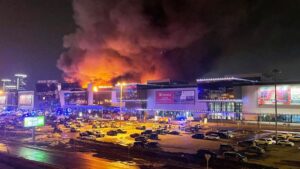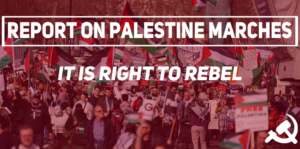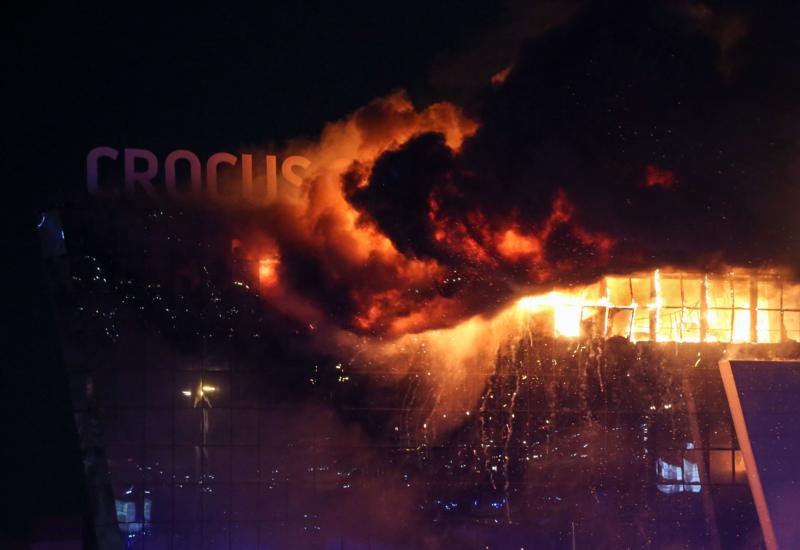
Attack of the ISIS-K in Moscow: “The war comes back” to Russia’s heart
Featured image: the front of the concert hall Crocus City Hall of in Moscow. Source: Reuters
This Friday night of 22nd of March four armed men carried out an attack with assault rifles and incendiary devices in Krasnogorsk, Moscow’s metropolitan area, in the concert hall Crocus City Hall, where a concert was being held, where thousands of people had gathered. According to Yankee imperialism, they were informed about this possible attack and they shared the information with Russian authorities, making a warning from the Yankee embassy in Russia. Afterwards, the news agency of the Islamic State (ISIS), Aamaq (Wakālat Aʻmāq al-Ikhbārīyah), published videos of the armed men and the action carried out in the Crocus City Hall. Through this channel, the so called Islamic State – Khorasan Province (ISIS-K) claimed the attack. The armed men made a selfie celebrating the attack.
The death toll has reached already 133 people, according to official figures during the 23rd of March. Additionally are reported more than 100 injured, many of them of seriousness, and therefore the authorities states that the number of dead people most likely will increase. The Russian authorities have stated that the four responsibles for the armed action have been detained in Bryansk, southern Russia, when they tried to scape to Ukraine. In total there are 11 detained, including possible collaborators in the logistics of the action. Russian imperialism have used this attack, quickly accusing the Ukrainian State of being part of this action, and of being waiting at the border with Russia in order to provide shelter to the perpetrators of the action. The detained, according to Russian imperialism, would be from Tajikistan, Central Asia, area under the action range of ISIS-K.
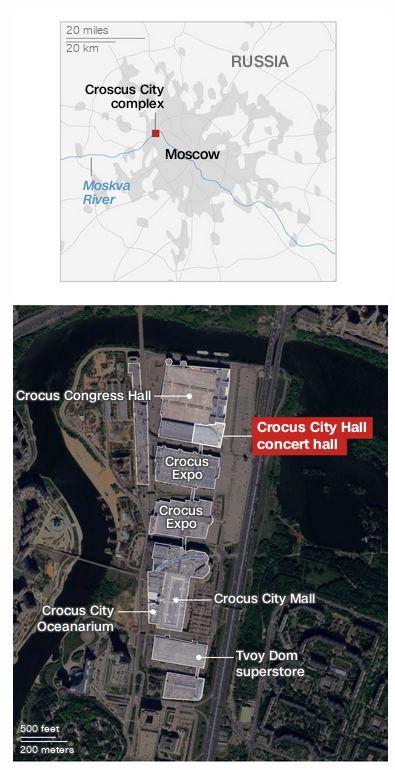
.
The group which claimed the action is the ISIS-K, the brand of the ISIS in Afghanistan and which acts in what they define as the Khorasan province, that means, the Central Asia area. Yankee imperialism stated that this organization had in their ranks around 1.500 and 2.000 combatants, and they would carried out abroad of their action range, being an increasing threat. This group was responsible of the attack in the Kabul’s airport during the fled of Afghanistan, and also was responsible of the action in Kerman, Iran, during the march for the anniversary of the murder of Soleimani. Yankee analysts mention that ISIS-K accuses Russian imperialism of having Muslim blood in its hands for its interventions in Afghanistan, Chechnya and Syria. In this case, the country of the authors of the attack at the Crocus City Hall, that would be Tajikistan, is within the action range of the ISIS-K, being Tajikistan part of what they would consider the “Khorasan Province”, region of Central Asia. Should be mentioned that in Afghanistan, where the ISIS-K is particularly relevant, the Tajikistani people are an important minority.
Regarding the ISIS actions against Russian imperialism, in 2017 there were reports which pointed out the recruitment of more combatants from the former Soviet republics in Central Asia, and additionally, in 2015 pointed out that many Caucasus militants gave their pledge to the ISIS and formed the ISIS-Caucasus. In 2022 they made an attack against the Russian embassy in Kabul. At the same time, bourgeois academics point out the ISIS-K role not just an armed insurgent group in Central Asia, but as a group which is targeting all the actors which have an important role in the region, and therefore, its actions can target imperialist power’s national territory.
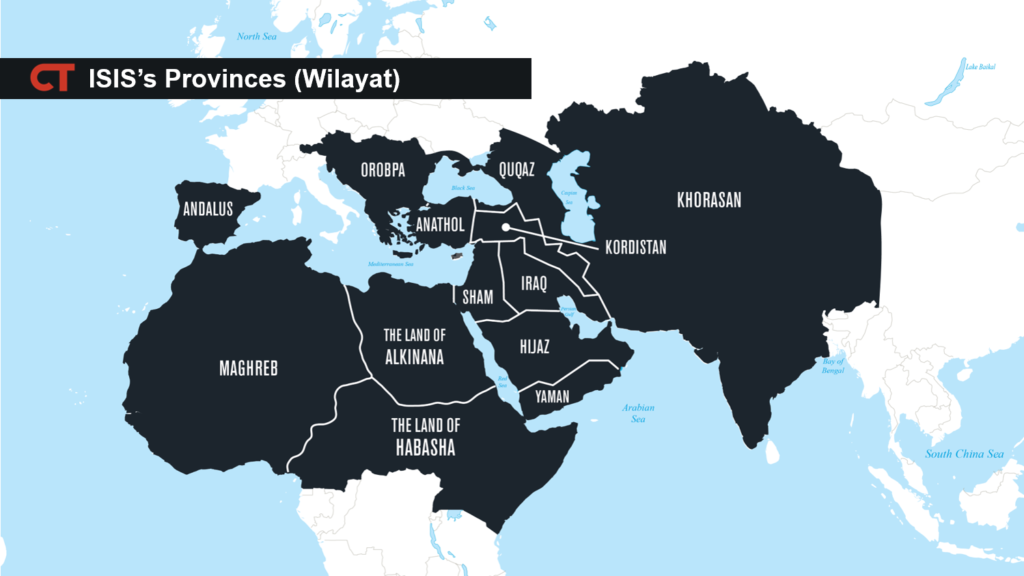
This attack on Russian territory is the deadliest since the Caucasus militants took the Beslan’s school, in North Ossetia in 2004. In this attack more than 300 people were killed. Also it is the deadliest attack in Moscow since the apartment bombings in 1999, which ended with the loss of life of almost 300 people. Both cases were responses to the Russian imperialism’s repressive police and the atrocities committed by it against the Caucasus’ peoples. There, Chechnya became a combatant territory against the Russian State.
The list of crimes of Soviet social-imperialism and Russian imperialism in Central Asia is very long: the invasion of Afghanistan was one of the biggest crimes they made in a long time, with a military occupation and the repression against the Afghan people, which last for almost a decade. Afterwards the involvement in the Tajikistan’s civil war between 1992 and 1997 was another of the Russian imperialist interventions in the region, and thus, the maintenance of the control of the Russian imperialism in the region, being Tajikistan and Kyrgyzstan two of the more oppressed countries by Russian imperialism in the area. Another country which suffered the Russian iron fist was Kazakhstan, which after the strong protests in 2022, saw a Russian military intervention in the same year in order to maintain the status quo. All of this, along with the wars in Chechnya were crimes which were seen by the Muslim population as attacks against its identity, and therefore brought Russian imperialism to be seen as an specially reactionary element against its peoples. Additionally the Muslim population in Moscow, coming from oppressed nations and peoples, has denounced increasing attacks and Islamophobia since its migration to the Russian capital skyrocketed since the 90’s.
The crimes from Russian imperialism has been relevant in many other places against Muslim population, as in the military interventions and support to local lackeys in Africa and Middle East, in the wars of Libya, Syria, massacres committed and support to the local lackeys’ regimes in Mali, Niger, Center-African Republic, Sudan or Burkina Faso. Or event with the increasing collusion with some of the local ruling classes of Middle East, as with United Arab Emirates with which they collaborate in Sudan, as we recently reported.
This policy of aggressions and repression against the oppressed peoples and nations of the world – some of them, currently as in the Caucasus, under Russian direct military occupation -, shows how Russian imperialism is a big oppressor of the peoples from the world. Many of these peoples share the Islamic religion, some that has been used by organizations as ISIS-K and diverse insurgent groups, to lead the masses’ wrath against Russian imperialism. This also shows a historical reality of the imperialist interventions, and it is, when they bring war abroad, then the war comes back home. The Soviet social-imperialism, and after it, Russian imperialism, brought war to the homes of Afghan people, and to the homes of the Caucasus, Africa, Middle East peoples… and after all of this came back in form of multiple armed actions in Russian territory and in form of insurgency in these territories. All of this points out that, despite that, as we reported, Russian imperialism is achieving to slowly advance in its main current challenge, which is the imperialist war of aggression against Ukraine, and it is still being a relevant actor in the international scenario, and that it is not almighty. The brutal repression in the internal level and the great military power have not been enough, showing once again that imperialism is a paper tiger when it oppresses and faces the peoples from the world.
